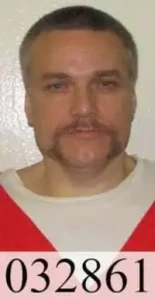Ronnie Lee Bowling was sentenced to death by the State of Kentucky for two murders committed during robberies
According to court documents Ronnie Lee Bowling would fatally shoot a clerk in a robbery and then soon after would fatally shoot another clerk in a second robbery:
Ronnie Lee Bowling would be arrested, convicted and sentenced to death
Ronnie Lee Bowling Photos

Ronnie Lee Bowling FAQ
Where Is Ronnie Lee Bowling Now
Ronnie Lee Bowling is incarcerated at Kentucky State Penitentiary
Ronnie Lee Bowling Case
On January 20, 1989, Ronald Smith worked his usual midnight to 8 a.m. shift at the Jones Chevron station in London, Kentucky. Smith had $200 in the cash register when he started his shift, and he usually worked alone until 6:30 a.m. Around 5:30 a.m., two customers noticed that the gas pumps were not working. They went inside and found Smith lying face-down on the floor—dead. The cash register reflected $354 in sales over the course of the night, with a “no sale” indicated at 5:21 a.m, but the register was empty except for coins. Smith had been shot six times: three times in the back of the head, twice in the back, and once in the chest.
A month later, on February 22, 1989, Marvin Hensley opened his gas station one-and-a-half miles north of London around 6:00 a.m. One customer bought five dollars of gas from him at 6:15 a.m. But when another customer entered the station at 7:00 a.m., he found Hensley dead on the floor. Hensley, who was also a minister at a church in Mt. Vernon, had suffered three gunshot wounds to the back of his head, one to his ear, one to the back of his neck, and one to his hand. Again, the station’s cash register was empty except for coins.
The Smith and Hensley murders received extensive attention in the local news, and gas station operators began to take additional security precautions. One such operator was Ricky Smith (no relation to Ronald), who owned and operated a Sunoco station on U.S. Highway 25 in Rockcastle County, Kentucky. On February 25, 1989, Smith opened his station around 6:00 a.m. Not long afterward, Ronnie Lee Bowling entered the station. Bowling told Smith he was looking for a job, but kept his hands in his pockets and asked Smith if the station ever had two employees on duty at the same time. Smith also recalled that Bowling looked out the station window, up and down the highway in both directions.
Smith told Bowling that the station was not hiring, and Bowling began to leave. But as Bowling exited, he pulled out a revolver and started firing at Smith. Reacting quickly, Smith dove behind a wall and metal desk and pulled out his own gun. When he heard Bowling finish shooting, Smith returned fire at Bowling through the wall. When Smith fired back, Bowling ran out of the station, jumped in to his car, and headed south on Highway 25.
Smith called the Kentucky State Police, told them what happened, and gave them a description of Bowling. State Police Troopers Allen Lewis and Danny Alton quickly intercepted Bowling’s car and began pursuing it. When Lewis switched on his blue lights, Bowling responded by accelerating. The pursuit continued for more than thirty miles, and, according to Lewis, frequently exceeded speeds of 100 miles per hour. By the time Bowling stopped at an area near his residence, eight to ten other police cars were involved in the chase. The police arrested Bowling and noticed that he was bleeding from his head.
During the chase, police observed Bowling throw two brown objects out of his car near the nine-mile marker of Kentucky Highway 472. When police returned to this location, they found a pair of brown gloves. State police troopers searching the entire route of the chase made an even more important discovery—near the area where the chase began, they found a .38-caliber revolver. Ricky Smith identified the gun as similar to the one Bowling brandished at the Sunoco station.
When the police arrested Bowling, he told them that he entered Ricky Smith’s gas station to look for a job. According to Bowling, Smith lost his temper during the conversation and began shooting. Bowling claimed that he never had a gun at the gas station, and that he did not throw anything out of his car while fleeing from the police. Bowling also denied ever owning a handgun. When Bowling gave his initial statement to the police, he was bleeding because one of Smith’s shots had grazed the side of his head.
Bowling’s trial lasted from September 21 to October 9, 1992. At the trial, a Kentucky State Police forensic scientist presented evidence of tests that analyzed the lands and grooves of the .38-caliber revolver that police found on the side of the road and the bullets found at the crime scenes. These tests revealed that one of the bullets that killed Ronald Smith and four of the bullets that killed Marvin Hensley matched the handgun found on the side of the road. Bullets found at the third crime scene, Ricky Smith’s Sunoco station, were too badly warped for the forensic scientist to conclusively tie them to the .38-caliber revolver. The bullets were, however, the type that a .38-caliber revolver could have fired.
